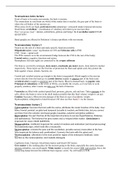College aantekeningen
Neuroscience notes + exam notes
- Instelling
- Vrije Universiteit Amsterdam (VU)
In this document I wrote my summary with class notes for the course Neuroscience. Whenever you read the word 'EXAM' in the text, this means the question came back in my previous exam and you should really study this part for your exam. I got a 7 with these notes, hope you make it good too. Good luc...
[Meer zien]




